Burao
Burao (var. Bur'ao,[2] Somali: Burco, Arabic: برعو) is the capital of the Togdheer region[3] and the second largest city in Somaliland.[4] Burao was the site of the declaration of an independent Somaliland on May 18, 1991.[5]
Burao
Burco برعو | |
|---|---|
City | |
  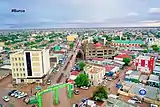    | |
 Flag 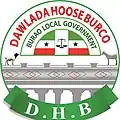 Seal | |
.svg.png.webp) Burao Location in Somaliland 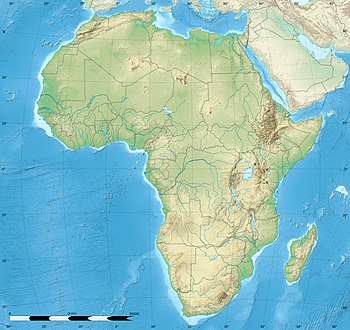 Burao Burao (Africa) | |
| Coordinates: 09°31′40.4″N 45°32′04.2″E | |
| Country | |
| Region | Togdheer |
| District | Burao |
| Government | |
| • Mayor | Mohamed Yusuf Abdirahman |
| Area | |
| • City | 42 km2 (16 sq mi) |
| Elevation | 1,037 m (3,402 ft) |
| Population (2020) | |
| • City | 750,211 [1] |
| • Metro | 548,211 |
| Time zone | UTC+3 (EAT) |
| Climate | BWh |
History
19th century
For much of the 19th century, Burao served as the Capital of the Habr Yunis Sultanate. Both Sultan Nur Ahmed Aman and Sutan Awad Diiriye ruled from Burao.[6][7]
After leaving the Berbera coastlands and ascending the escarpments of the great inland plateau, the convoy followed the valley of the Tug Dayr as far as Burao, capital of a powerful but friendly Habr Gerhaji sultan.[8]
Explorer Frank Linsly James, a guest of Sultan Awad Diiriye during his visit to Somaliland in 1884, describes a performance he witnessed by Habr Yunis Horsemen at Burao's Togdheer River.
During our stay at Burao, the Sultan collected a great many of his people together, and twice entertained us with some well-executed and characteristic evolutions on horseback. On the first occasion some forty mounted men were collected in the Tug before our zariba; but this did not satisfy the Sultan, and he arranged a second "fan- tasia," in which fully two hundred warriors were engaged. It was the best and most characteristic thing of the kind I had ever seen. A procession was first formed in the river's bed, and on a given signal all dashed off, brandishing their spears and shields. Dressed in tobes of many colours, and sitting loosely on their gaily caparisoned horses, they engaged in mimic contest with spear and shield, reining their horses upon their haunches when at full gallop, and with wild shouts flinging their spears into the air. Each warrior carried a short-handled whip with a broad raw hide thong, and with it lashed his steed unmercifully. Some of the riders went through regular circus feats, leaping from their horses when at full gallop, picking up objects thrown on the ground, and then remount- ing. After this had continued for some time they would gallop close to our zariba, and reining up, shout "Mort, mort" ("Welcome, welcome"), to which we replied, "Kul liban" ("Thanks").[9]
Dervish movement
The Dervish state was founded in Burao in 1899. In the end of late August of that year the Dervish leaders and their clan followers assembled at Burao, Mohammed Abdullah Hassan with his followers from the Dhulbahante, the various Habar Jeclo sub clans with their principle headman Haji Sudi, and Sultan Nur Ahmed Aman with his followers from the Habr Yunis clan, declared open hostility.[10] The assembled dervish and their clan allies sent the following stern letter to Captain Cordeauxe and James Hayes Sadler:
"This is to inform you that you have done whatever you have desired, and oppressed our well-known religion without any cause. Further, to inform you that whatever people bring to you they are liars and slanderers. Further, to inform you that Mahomed, your Akil, came to ask from us the arms we therefore, send you this letter. Now choose for yourself; if you want war we accept it, if you want peace pay the fine." September 1, 1899.[11]
Burao Tax Revolt, 1922

Sections of the Habr Yunis clashed with the British in 1922 after a tax was imposed upon them at Burao. This resulted in the Baho Ainanshe and Rer Sugulleh sub-clans revolting in opposition to the tax and clashing with other sections of the Habr Yunis and the British colonial government. This resulted in a shoot out in which Captain Allan Gibb, a Dervish war veteran, was shot and killed. The British as retaliation burnt down Burao and requested from Sir Winston Churchill, then Secretary of State for the Colonies, to send troops from Aden and Airplane bombers in order to bomb the wells and livestock of the Rer Ainanshe clans and quell any further rebellion.[12] After the killing of Gibb all Europeans entered the Burao fort, which at the time was occupied by the Native Somali B Company of the Somaliland Camel Corps. The Hargeisa Camel Corps was wired and informed of the incident and ordered to send troops to Burao. The Indian Sepoys having been sent back to the sub-continent forced the Government to rely on the Somali B company, but when ordered to open fire on the hostile Habr Yunis tribesmen, they declined. The British had to resort to sending Indian troops from Aden as they could not trust the native Somalis. Instead The B company was tasked with collecting the fine imposed on the Rer Ainanshe. B company was eventually disbanded and replaced with the more obedient Yao Askaris from the 1st King's African Rifles.[13][14][15]
Two Airplane bombers were subsequently flown from Aden, ready to bomb the livestock of the Rer Ainanshe clans who were implicated in the shooting lest they refuse to pay a fine and hand over the culprits. Bomber planes were flown over Burao and the Haud, while watering wells that were essential to the Rer Ainanshe nomads were blocked by the Camel corps, the Rer Ainanshe clans isolated and without support eventually acquiesced, agreeing to pay the fine but they refused to identify and apprehend the accused individuals. Most of the men responsible for Gibb's shooting were never caught and evaded punishment.[16][17] Captain Gibb was among the most respected and valued British Officers in British Somaliland, he fought during the Dervish wars and operated a Maxim Gun, and was credited with capturing Taleh fort in 1920.[18]
Sir Winston Churchill reporting on Gibb's shooting at the House of Commons:
On 25th February the Governor of Somaliland telegraphed that an affray between tribesmen had taken place at Burao on the previous day, in the course of which Captain Allan Gibb, D.S.O., D.C.M., the District Commissioner at Burao, had been shot dead. Captain Gibb had advanced with his interpreter to quell the disturbance, when 1954 fire was opened upon him by some riflemen, and he was instantly killed. The murderers escaped under cover of falling darkness. Captain Gibb was an officer of long and valued service in Somaliland, whose loss I deeply regret. From the information available, his murder does not appear to have been premeditated, but it inevitably had a disturbing effect upon the surrounding tribes, and immediate dispositions of troops became necessary in order to ensure the apprehension and punishment of those responsible for the murder. On 27th February the Governor telegraphed that, in order to meet the situation which had arisen, he required two aeroplanes for purposes of demonstration, and suggested that two aeroplanes from the Royal Air Force Detachment at Aden should fly over to Berber a from Aden. He also telegraphed that in certain circumstances it might become necessary to ask for reinforcements of troops to be sent to the Protectorate.[19]
Burao was the site of the unilateral declaration of an independent Somaliland on May 18, 1991.[5]
Demographics
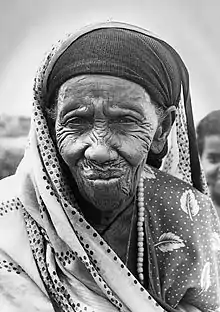
Burao is the second-largest city in Somaliland with a population of 288,211 according to the (2005) UN estimate [20]
The main residents of Burao are the Habr Je'lo, Habr Yunis, Issa Musse and Arap, which are all subdivisions of the larger Isaaq Somali clan.[2]
Municipality and services
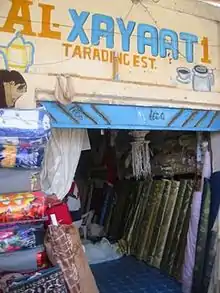
The city enjoys full-time electricity and a reliable water supply from groundwater. In addition, Burao's central location has contributed to its economic revival. Goods travelling to the south, central and eastern parts of Somaliland all depart from the city's outskirts. Rural merchants also sell their produce on a daily basis, which attracts business.
In 2007, Burao's city authority (in conjunction with development organizations and local traders) opened the Burco Meat and Produce complex. One year in the making, the market has two main halls and can accommodate more than 2000 merchants.[21]
The Burao Municipality is led by Mayor Mohamud Ahmed Hassan.[21]
Geography
Weather in Burao, much like other inland towns in Somaliland, is warm and dry year-round. The average daytime temperatures during the summer months of June and August can rise to 31 °C (95 °F), with a low of 20 °C (77 °F) at night. The weather is cooler the rest of the year, averaging 27 °C (80 °F) during the day and 13 °C (57 °F) at nighttime. The city's limited rainfall of 222 mm usually comes with two peaks during April–May and October–November.
The Togdheer River runs through the town. It is often dry but subject to flooding. The river divides the city in half, and can be crossed via a newly built bridge in the city center.
Burao's landscape is semi-desert and fairly flat.
Climate
| Climate data for Burao | |||||||||||||
|---|---|---|---|---|---|---|---|---|---|---|---|---|---|
| Month | Jan | Feb | Mar | Apr | May | Jun | Jul | Aug | Sep | Oct | Nov | Dec | Year |
| Average high °C (°F) | 26.5 (79.7) |
28.0 (82.4) |
29.7 (85.5) |
30.7 (87.3) |
31.3 (88.3) |
31 (88) |
29.4 (84.9) |
30.4 (86.7) |
31.6 (88.9) |
29.8 (85.6) |
27.6 (81.7) |
26.5 (79.7) |
29.4 (84.9) |
| Average low °C (°F) | 12.7 (54.9) |
13.8 (56.8) |
15.6 (60.1) |
17.3 (63.1) |
18.4 (65.1) |
19.4 (66.9) |
19.4 (66.9) |
19.5 (67.1) |
19.4 (66.9) |
16.2 (61.2) |
14.3 (57.7) |
13 (55) |
16.6 (61.8) |
| Average precipitation mm (inches) | 2 (0.1) |
0 (0) |
6 (0.2) |
50 (2.0) |
59 (2.3) |
14 (0.6) |
13 (0.5) |
13 (0.5) |
30 (1.2) |
26 (1.0) |
9 (0.4) |
0 (0) |
222 (8.7) |
| Source 1: Weatherbase [22] | |||||||||||||
| Source 2: Climate Data.ORG [23] | |||||||||||||
Wildlife
Due to the fertility and greenery of the region, wild animals come to the area either to breed or to graze on the grassland savannah. Prominent animals found locally include the kudu, wild boars, zebras, the Somali Wild Ass, warthogs, antelopes, the Somali sheep, wild goats, camels, and many different types of birds. Due south of Burao is a grassland savannah, which attracts many types of fauna to the region, including lions and leopards.
Transportation
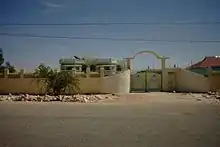
Burao has a working bus system. Air transportation needs are served by the Burao Airport, which offers flights via Daallo Airlines to Hargeisa and other cities in the Horn of Africa, as well as international locations such as Addis Ababa and San'a. As of 2012, the airport's facilities are undergoing major renovations, supervised by the International Civil Aviation Organization (ICAO).
Notable residents
- Abdirahman Ahmed Ali Tuur – First President of Somaliland
- Ubah Ali - anti-FGM activist
- Muhammad Haji Ibrahim Egal – Second President of Somaliland
- Ahmed Mohamed Mohamoud – Fourth President of Somaliland
- Hadraawi – renowned Somali poet
- Saad Ali Shire – incumbent Minister of Finance of Somaliland
See also
References
- http://www.somalilandtour.com/index.php/features/layout/full-content
- UNDP Emergencies Unit for Ethiopia (1994-11-15). "Report on Mission to Haud Area, Region 5". Retrieved 2012-04-23.
Habr Yonis. only major 'urban' centre is Bur'o, a town they share roughly equally with the Habr Je'lo and Issa Musse
- "Somaliland's Quest for International Recognition and the HBM-SSC Factor". Archived from the original on May 28, 2012.
- "Somalia Districts". www.statoids.com.
- "Somaliland History". World66. Internet Brands. Archived from the original on 2007-09-30. Retrieved 2007-07-17.
In 1991, after the collapse of the Somali government
- British SomaliLand by Ralph E Drake Brockman, p.66
- The Unknown Horn of Africa: An Exploration From Berbera to the Leopard River, By Frank Linsly james, p.62
- The Academy, Volume 35, 1889, p.126
- The Unknown Horn of Africa: An Exploration From Berbera to the Leopard River, By Frank Linsly james, p.67
- Sessional papers Volume 48 p. 8
- Sessional papers Volume 48. p. 15
- Colonial Office, April 11, 1922
- Public Record Office file WO 106/272 (Digest of History of Somaliland Camel Company KAR)
- Public Record Office file CO 1069/13 Part 1, by the first officer commanding “B” (Nyasaland) Company SCC).
- The King’s African Rifles by H. Moyse-Bartlett
- Correspondence between Governor of British Somaliland and Secretary of State for the Colonies. Colonial Office, 28th February, 1922
- Correspondence between Governor of British Somaliland and Secretary of State for the Colonies. Colonial Office, 26th March, 1922
- Jaques, Tony (2007). Dictionary of battles and sieges P-Z, p.991. ISBN 9780313335396.
- 1922 Commons sitting. HC Deb 14 March 1922 vol 151 cc1953-4
- "Regions, districts, and their populations: Somalia 2005 (draft)" (PDF). UNDP. Retrieved 21 September 2013.
- "Qaran News". www.QaranNews.com. Retrieved 14 January 2018.
- "Weatherbase: Historical Weather for Burao, Somalia". Weatherbase. 2011. Retrieved November 24, 2011.
- "Climate: Burao, Somalia". Climate-Data.org. 2013. Retrieved December 28, 2013.